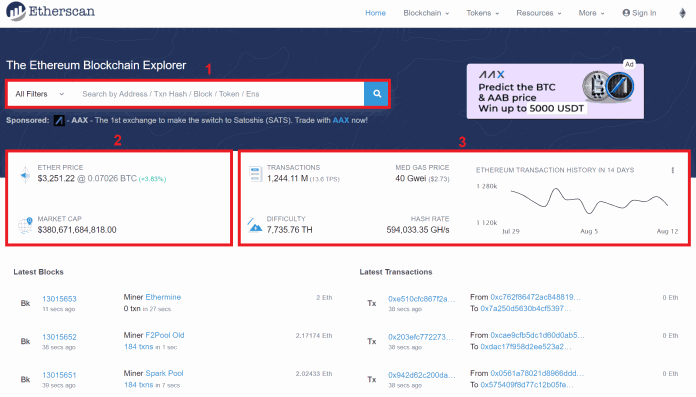Welcome to the world of Ethereum, a revolutionary blockchain platform that has been transforming various industries. As you embark on your journey into the Ethereum ecosystem, it is crucial to understand how to navigate and explore the blockchain. In this blog post, we will introduce you to Etherscan, one of the most popular Ethereum blockchain explorers available today. Whether you’re a beginner or an experienced cryptocurrency enthusiast, this comprehensive guide will provide you with all the information you need to leverage Etherscan effectively.
What is Etherscan?
Etherscan is a web-based blockchain explorer specifically designed for the Ethereum network. It allows users to explore and search for various transactions, addresses, smart contracts, and network statistics on the Ethereum blockchain. Etherscan provides real-time data and insight into every aspect of the Ethereum network.
Advantages and disadvantages of Etherscan:
Advantages: Etherscan is currently considered the most reliable and trusted Blockchain Explorer. All information is transparent and publicly available. Thanks to the “alerts” from Etherscan, users can predict and understand the overall cryptocurrency market or specific projects they invest in. For example, users can search and read information, such as when a “whale alert” transfers many tokens to a certain exchange. Although this may not directly affect the user’s investment, it can still predict a potential sell-off.
Disadvantages: The interface can confuse new users due to overwhelming information. Users need to register an account to access more advanced features.
The purpose of using Etherscan
Checking ETH wallet: This is one of the most common uses of Etherscan. You need to have the wallet address you want to check (it can be your own wallet address or someone else’s). Then, search in the search box, and you can check basic information about that wallet, such as the types of tokens in the wallet, the balance of the entire wallet in USD, and the balance of each token.
Checking ETH transactions.
Retrieving wallet information when having a Txn Hash.
Checking Smart Contracts of project tokens.
Checking project wallet balances.
For the above purposes, some specific cases for using Etherscan.io are as follows:
- Checking your own or someone else’s wallet balance.
- Checking ETH transactions and tracking pending token transactions on the system.
- Checking wallet balance fluctuations of projects.
- Checking transaction status when there are disputes during token transfer on Ethereum.
- Creating a watchlist to monitor token fluctuations in wallets during Airdrop Bounty campaigns.
- Checking Smart Contracts of project tokens to learn about ICO or IEO projects.
In addition, Etherscan also provides an API. Developers of dApp projects can use this API for their applications. Or, if you have your own website and want to display activity data on the Ethereum Blockchain network, you can use the API to show it on your website.
Key Features of Etherscan
The image below is the basic interface of Etherscan when you access etherscan.io.
Basic interface

Features and basic information on the Etherscan.io interface
Where:
[1] Search box: Here, you can paste Address, Txn Hash, Block, Token, or Ens to search for information directly.
[2] Basic facts about Ether (ETH): You can see the price, 24-hour price movement, and total market cap of ETH.
[3] Real-time information about the inner workings of Etherscan’s blockchain network.
Some information you may be interested in:
- Transactions: The total number of transactions executed.
- Med Gas Price: The current average gas price on the Ethereum network.
- Difficulty: The difficulty of mining.
- Hash Rate: The hash rate.
- Ethereum Transaction History in 14 Days: This graph shows the change in transaction volume on the Ethereum Blockchain over the last 14 days.
Blockchain
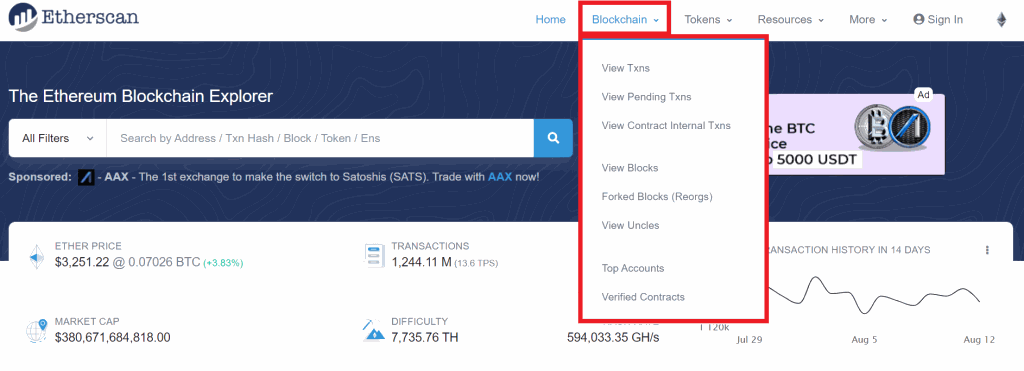
Blockchain feature on Etherscan.io
Delivering the homepage allows us to see an overview of the operation of the Ethereum Blockchain. Then the Blockchain button will allow you to see in more detail all the important information about Block, tx, and top account:
- View Txns: View all completed transactions on Ethereum.
- View Pending Txns: View transactions that are pending.
- View Contract Internal Txns: View ETH transactions.
- View Blocks: The Pool trains block.
- Top Accounts: A list of wallets that contain the most ETH.
- The rest are not important; you can explore more yourself: Forked Blocks (Reorges), View Uncles, Verified Contracts,…
Tokens
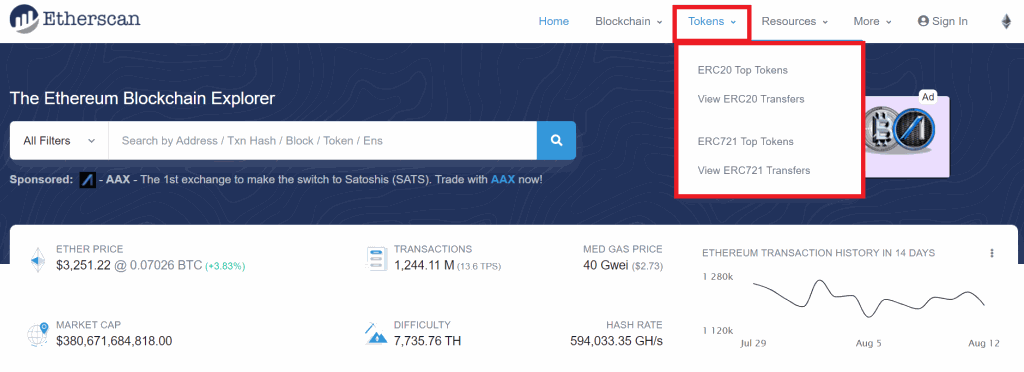
Tokens feature on Etherscan.io.
It contains information about two popular Ethereum tokens, ERC-20 and ERC-721, including:
- Top Tokens: List of tokens.
- Views Transfers: View transactions of these 2 tokens.
Resource
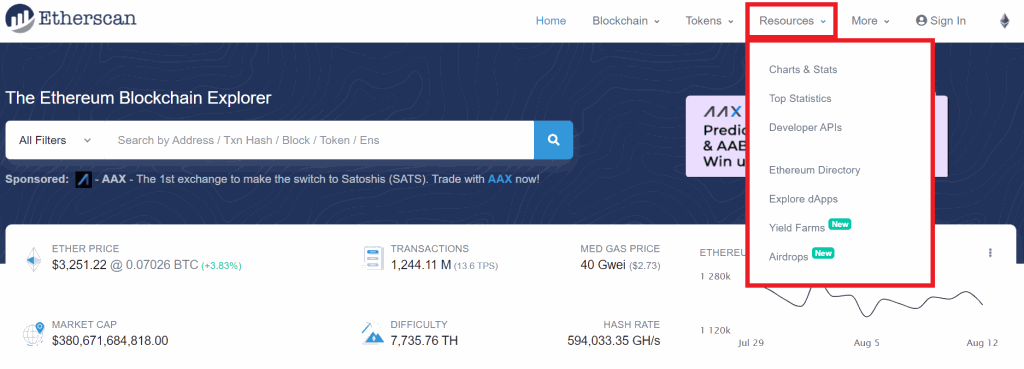
Resources feature on Etherscan.io
Items in the resource include:
- Charts And Stats: This is the section I want to introduce in more detail to you. This includes graphs and statistics from the Ethereum Blockchain network.
- Top Statistics: Data statistics of transactions, tokens,… top
- Developer APIs: Create APIs based on Etherscan.io APIs
- Ethereum Directory: Contains information about some related projects, websites, and exchanges providing services related to Ethereum.
- Explore dApps: A place to discover decentralized applications (dApps).
- Yield Farms: Projects that allow Yield Farming users to make money.
- Airdrops: Projects that are organizing Airdrops for users.
Some statistical graphs you should consider in the Charts And Stats section:
- Ethereum Transaction History: Represents the transaction volume in the Ethereum Blockchain. Based on this, you can partly grasp the trend of market movement.
- Ether Supply Growth Chart: This represents the total supply of Ether to the market. Based on this, you can know Ether’s trend and inflation rate.
- Transactions fee: the cost of transactions on the Ethereum network.
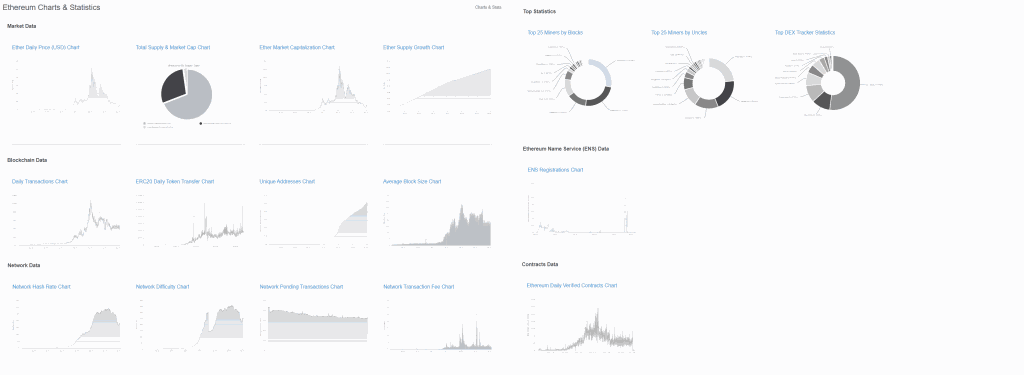
Types of charts and data statistics on etherscan.io
More
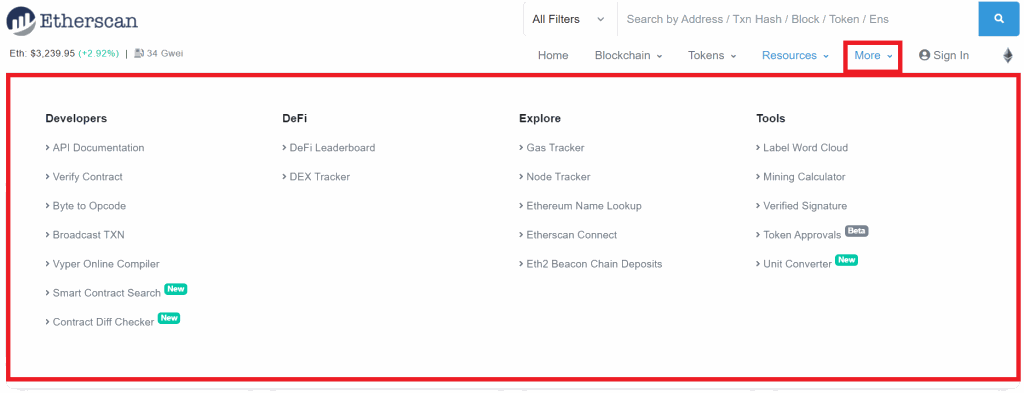
These include:
- Developers: Contains information about API, Decode… that programmers can use for their own development purposes. Also, look for contracts based on Similar Codes.
- DeFi: Check the information related to DeFi projects and decentralized exchanges DEX on Ethereum.
- Explore: Check the information on gas fees, nodes, etherscan connections, and deposits to Ethereum 2.0’s Beacon Chain and look for .eth domain names
- Mics: Check information about computing in mining, information related to SWARM distributed storage service, and signature verification,…
Instructions on how to use Etherscan.io
Check ETH – Ether Wallet
To read Ether wallet information with Etherscan, you first need a wallet address.
In the example below, I took the Donation wallet address of Etherscan to illustrate for you to understand: 0x71C7656EC7ab88b098defB751B7401B5f6d8976F
You need to Paste this wallet address into the search box and then Search.
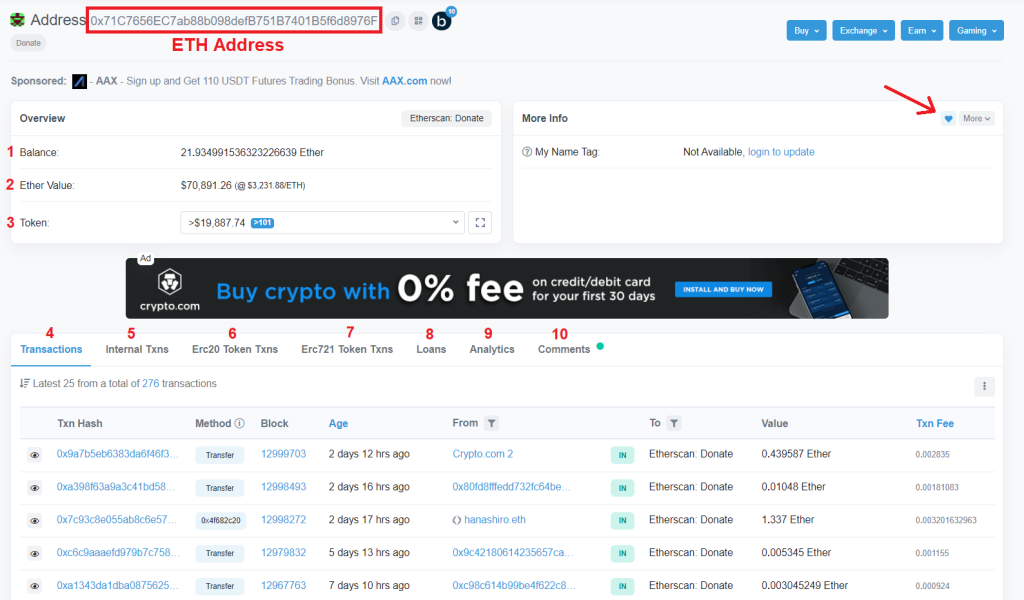
Check the ETH wallet on Etherscan
Here the information you receive includes:
- Balance: The balance inside the wallet, in Ether (ETH) units.
- Ether Value: The balance inside the wallet, in units of USD.
- Tokens: A list of tokens inside an Ether wallet. You need to click on the box next to you will see the full list.
- Transaction: A list of transactions made with that wallet.
- Internal Txns: Internal transactions.
- Erc20 Token Txns: Transactions made with ERC-20 tokens alone.
- Erc721 Token Txns: Transactions made with ERC-20 tokens alone.
- Loans: Loans and loans made.
- Analytics: Some statistical graphs and analysis related to transactions and wallet balances.
- Comments: Comments of accounts on Etherscan with that wallet.
You can also add this wallet address to your watchlist by clicking the heart-shaped button on the right-hand side, like the arrow image above.
Check tokens in Ether wallets.
Once you have the wallet address and search for the basic information inside the wallet. If you want to check in more detail about the types of tokens and the balance of each token inside that wallet, you can do it below.

Check the details of the tokens in the ETH wallet on Etherscan.io
Clicking on the “View expand ERC-20 token holding” button will display detailed information about the token in the wallet:
- 269 tokens are in this wallet.
- The list of tokens and balances of each type is clearly shown below.
This detailed information check suits brothers who often do Airdrop or Bounty. Many projects will pay tokens, but you may not know the token payment schedule. You can use this way to check whether the token has returned to the wallet.
In addition, if you want to check quickly, you can click on the arrow box in the Token section as shown in the Search ⇒ or scroll down to see the corresponding token and balance.
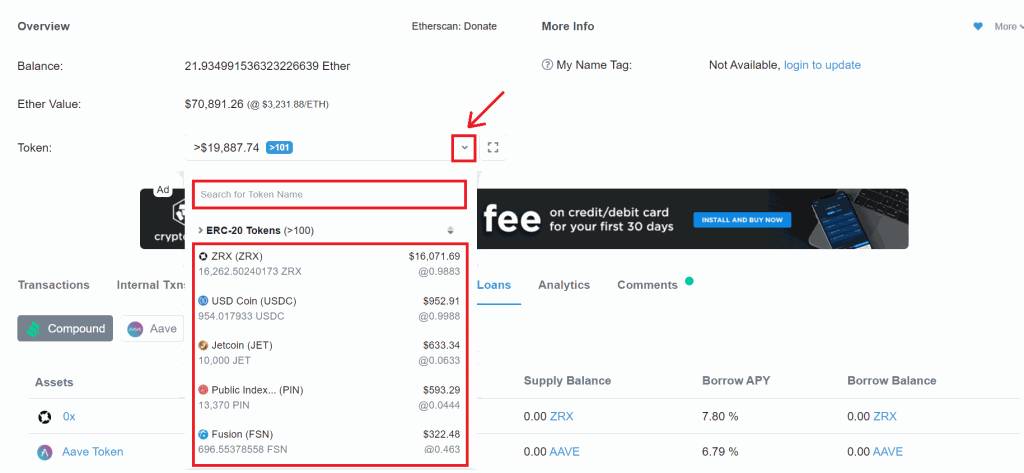
A quick check of ETH wallet tokens on Etherscan.io
According to the figure above, there are about 16,262 ZRX tokens in the wallet with a value of $16,071.69.
Check ETH transactions using Txn Hash.
Txn Hash is the transaction token. Each transaction that arises on the Ethereum Blockchain has its own unique Txn Hash. As long as you have Txn Hash code information, you can check that ETH transaction, and retrieve the transaction history and information of that wallet.
As in the wallet below, I paste Txn Hash: 0x2414117c50741d5f5ee6107bb8bea2fe19d4400f3ce4e39b8f0835b829bc91ef into the search box to check the transaction on Etherscan’s Donate wallet.
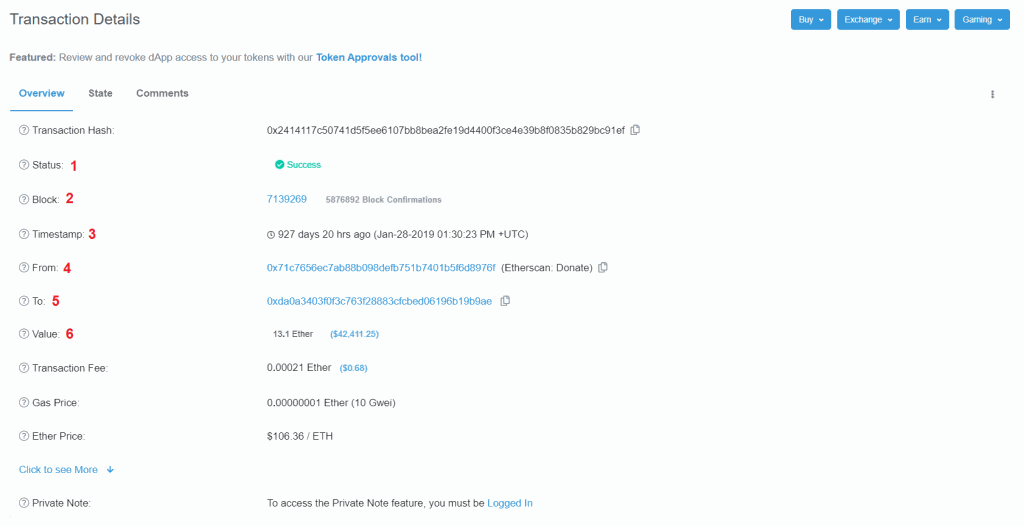
Some information received:
- Status: Success.
- Block: The transaction is recorded in block 7139269.
- Timestamp: The transaction took place over 927 days ago. Specifically: 927 days 20 hrs ago (Jan-28-2019 01:30:23 PM +UTC).
- From (Sender address): 0x71c7656ec7ab88b098defb751b7401b5f6d8976f
- To (Recipient address): 0xda0a3403f0f3c763f28883cfcbed06196b19b9ae
- Value: The value of the trade is 13.1 Ether or $2,421.67.
When to use Tnx Hash?
When brothers make transfers to each other in Ethereum’s blockchain network, the transaction takes time to confirm. You can copy this Txn Hash code to the receiver so that 2 parties can check the transaction status.
The closest example is when you buy ETH from an OTC exchanger. When transferring ETH to buyers, exchangers often copy the Tnx Hash to send to the buyer so that they can easily follow the transaction and know when the ETH will arrive in their personal wallets.
How to obtain the Etherscan API
To get the Etherscan API, you need to log in to your account on Etherscan. Or if not, click to sign up as shown below and proceed to fill in the information: username, email, password, and agree to the terms of Etherscan.
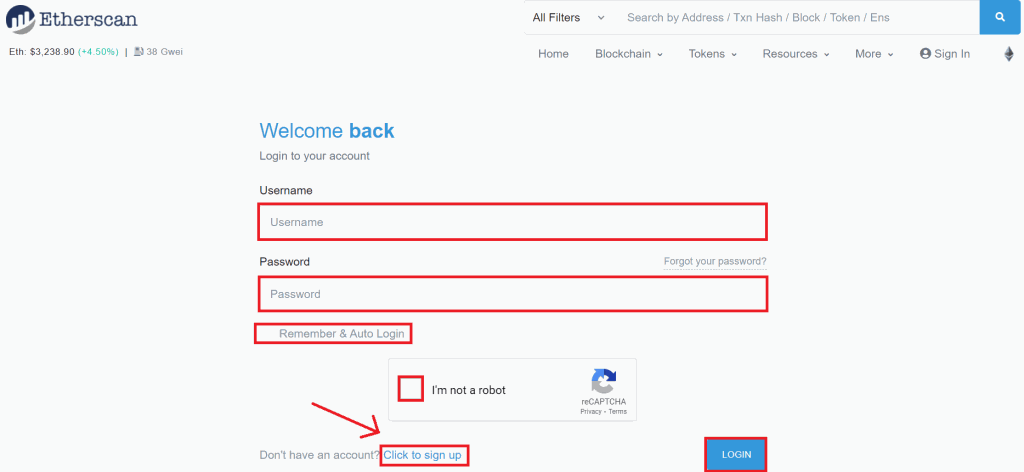
After logging into etherscan.io, select API-KEYs in the personal information section ⇒ Click Add to add API.

Then fill in the required information and select Continues.
This API Key is for developers who want to get information on Etherscan and display it on their application or website. Etherscan’s API provides information that includes Accounts, Contracts, Transactions, Blocks, Event Log, Geth/Parity Proxy APIs, Stats …
Check DEX information
The first decentralized exchanges, and popular with the crypto community, were those built on the Ethereum blockchain. With etherscan.io, you can check some basic information about these DEX brokers.
To check DEX Tracker Statistics, visit: etherscan.io/stat/dextracker
The chart below shows the Top DEXs and the number of trades made on them. You can customize the measurement time and download the chart in your desired format.
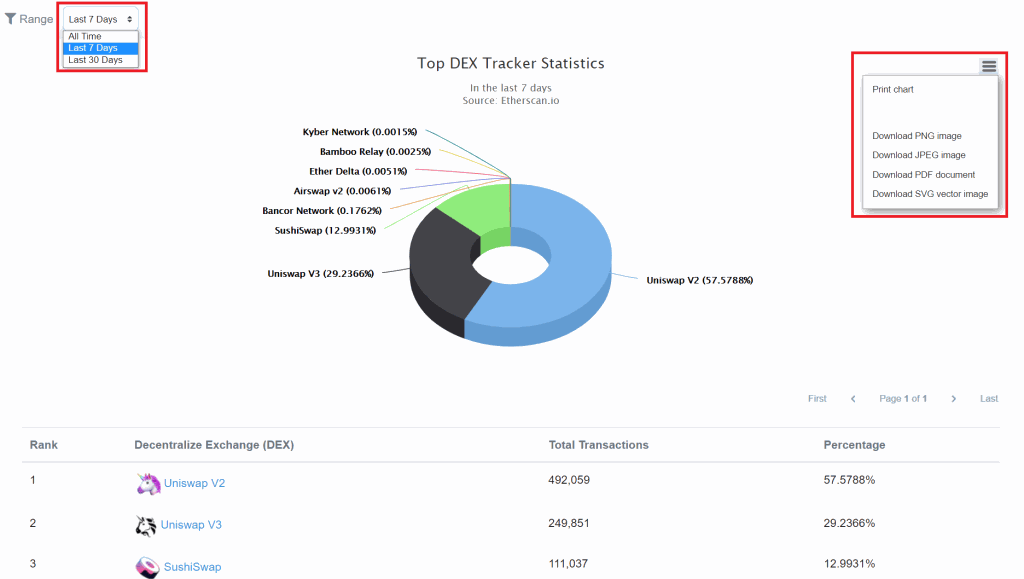
Chart of the number of trades executed by DEX exchanges
Based on the graph and information table below, you can easily grasp the number of transactions of each exchange and its order. From there, know the level of operation of these DEX exchanges.
According to the chart above, Uniswap is the DEX with the highest trading volume with V2 & V3. The trading volume of these 2 exchanges in the past 7 days accounts for more than 86% of the total trading volume on the Ethereum blockchain.
Check out the Mining Pool
Mining pools are pools that mine Ether (ETH) around the world. They are the ones who use the hardware power of the computer, and perform the work of validating transactions and creating blocks.
On Etherscan, you can check the list of major mining pools in the world by visiting: etherscan.io/directory/Mining
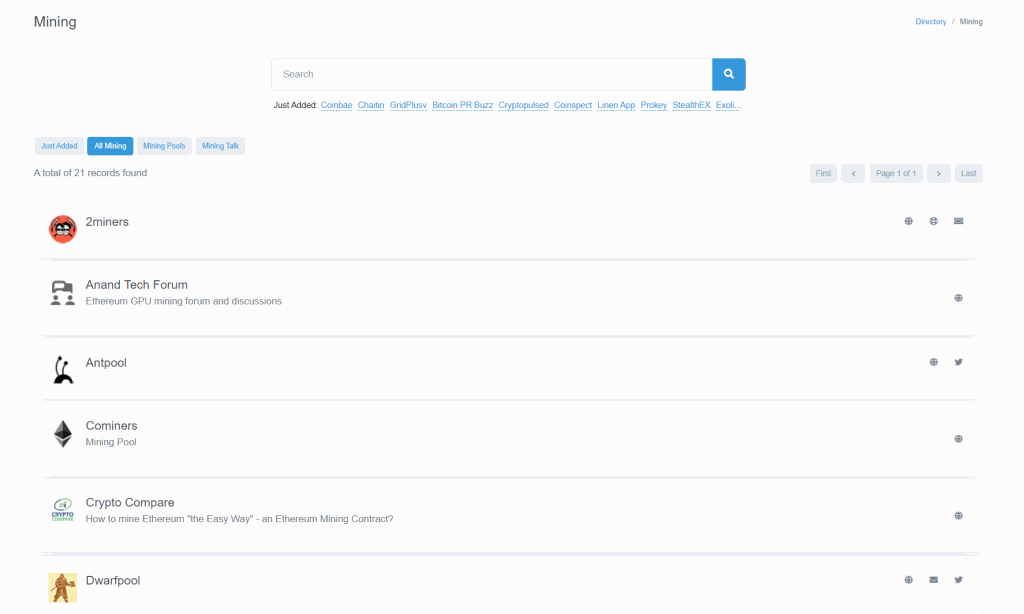
Mining Pool on Etherscan
Blockchain Event Audit
Some of the world’s major Blockchain events are also listed in Etherscan. You can see the list of events at the link: https://etherscan.io/directory/Events
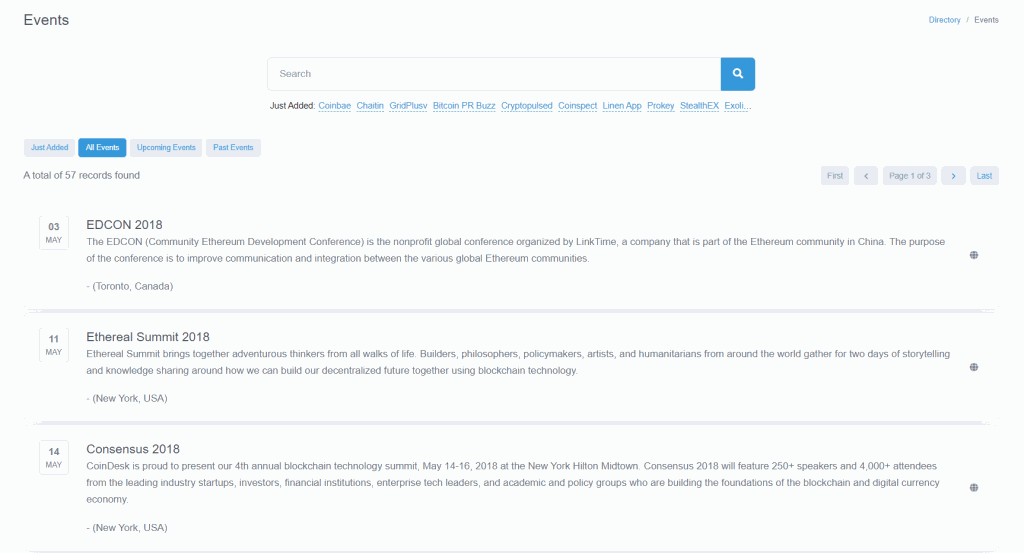
However, there are only a few major events or shows listed above. If you are interested in the events of each Blockchain project, you can use coinmarketcal.com to track them.
Checking Information in the Ethereum Blockchain
To check the most complete and general information about Ether (ETH), please visit: etherscan.io/stat/supply
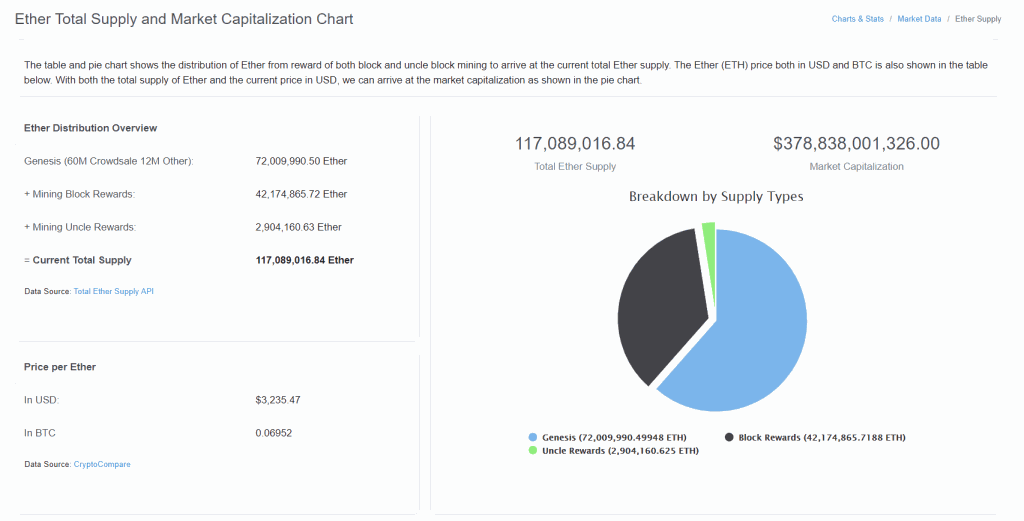
For example, as shown in the picture, at the time I made the article (13/08/2021):
- Total ETH in circulation: 117,089,016.84 ETH.
- Market Cap: $378,838,001,326.00.
- Mining Block Rewards: 42,174,865.72 ETH.
- Mining Uncle Rewards: 2,904,160.63 ETH.
4 tips for using Etherscan effectively
The instructions above are all ways to use the very basic features of Etherscan. In this section, I will share some tips I often use to use Etherscan when participating in the Crypto market.
Manage and track multiple Ether wallets simultaneously on Etherscan
The purpose of this management is that you can check and track multiple Ether wallet addresses simultaneously without spending much of your time. To use this feature, you need to register an account on Etherscan. Registering an account is quite simple; you can do it 1 quickly.
Once you have an Ethernet account, you access My Account >> Watch List. Or visit: etherscan.io/myaddress
You select the Add button to add the wallet addresses you want to track.
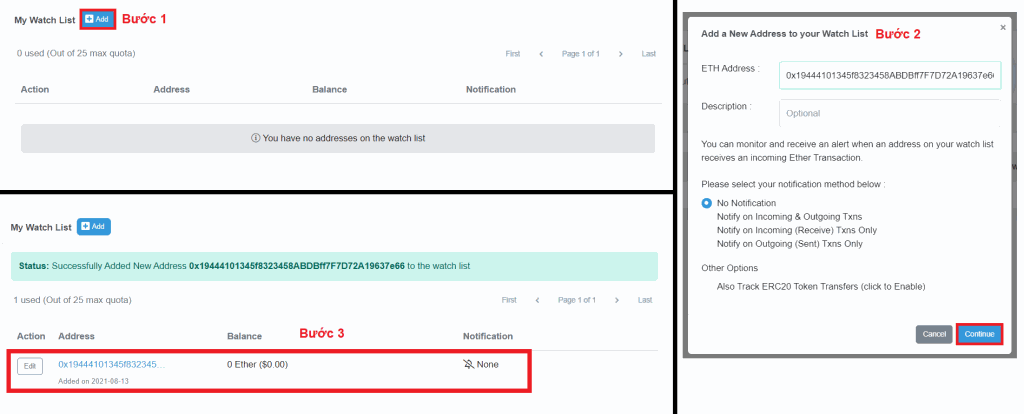
Add wallet addresses to your watchlist on etherscan.io
Check wallet balance fluctuations (team dev)
When investing in any Blockchain project, the dev team’s wallet is one of the pieces of information that many brothers want to know to check. When you get the dev team’s wallet address, you can check the balance, and wallet fluctuations, thereby knowing whether the dev team has unlocked the wallet and sold/discharged tokens. This directly affects the price of that token.
First, you need to know the exact wallet address of the dev team by checking in the whitepaper or the official information pages of the project.
If you can’t find it, you can chat directly with the project dev team on Telegram Group to ask. Below, I take an example of the Go With Mi (GMAT) project. The wallet address of the dev, advisor, and foundation team,… are made transparent by the project on the homepage here.
Next, you add these wallet addresses to the Watch List and then follow.

Check the team Dev wallet on etherscan.io
As shown above, I am following 2 wallets of the GoWithMi project, the Mining wallet and the dev team’s wallet.
Note: When adding these wallet addresses, you should select Notify on Incoming &; Outgoing Txns to receive email notifications when there are any balance fluctuations
Check the Smart Contract of the project correctly.
When you have a Smart Contract of the project, you can check the list of all project wallets (team dev wallet, advisor, foundation …), wallets, and transactions related to the project token. Therefore, checking the exact Smart Contract of the project is important for you when investing in any project.
The simplest and most effective way is to check directly with the project dev team to ask about their Smart Contract. If not, you can search for the project name or ticker/token in the search box.
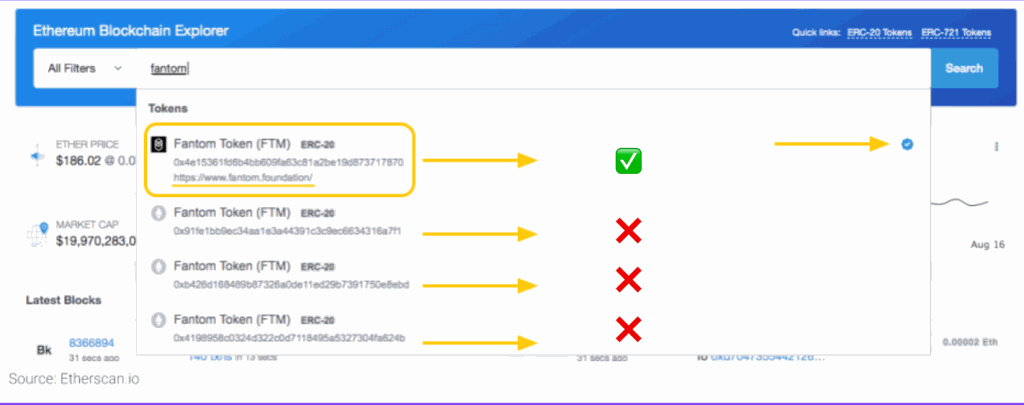
Check out Fantom’s credentials on etherscan.io
Example with the Fantom project:
- Total Supply: 2,138,153,790.FTM 589934657020549375
- Number of wallet addresses held (Holders): 30,049 wallets.
- Total Transfers: 324,874.
And some other insights:
- Holders: A list of large holders of FTM.
- Exchange: List of brokers that are waiting for FTM trading.
Below is a list of wallet addresses that hold the most FTM tokens. Based on that, you can know the fluctuations of these wallets (add to the list in Watch List).

Check out Fantom’s credentials on etherscan.io
Example with the Fantom project:
- Total Supply: 2,138,153,790.FTM 589934657020549375
- Number of wallet addresses held (Holders): 30,049 wallets.
- Total Transfers: 324,874.
And some other insights:
- Holders: A list of large holders of FTM.
- Exchange: List of brokers that are waiting for FTM trading.
Below is a list of wallet addresses that hold the most FTM tokens. Based on that, you can know the fluctuations of these wallets (add to the list in Watch List).
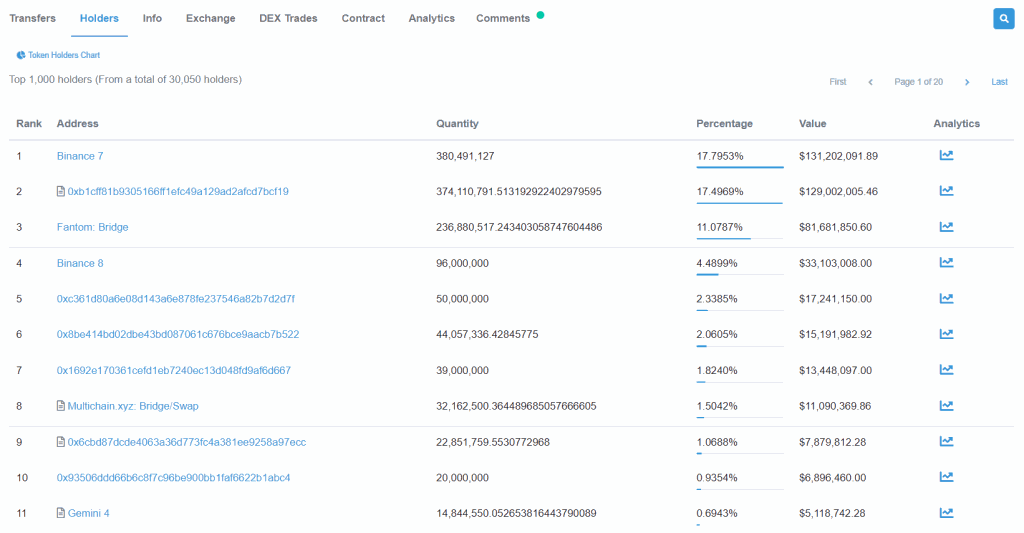
Wallet addresses holding the most FTM tokens
Note: The projects I mentioned above are all projects built on the Ethereum Blockchain platform. Some projects built on other Blockchain Platforms such as NEO, VeChain … then of course it will not be possible to check with Etherscan.
Calculate the amount of ETH mined
You can calculate the profit for mining ETH right on Etherscan by visiting: etherscan.io/ether-mining-calculator
Then pick up the excavator parameters and click Calculate to produce the result.

Calculate the amount of ETH mined in etherscan.io
As shown above, when owning an excavator, there are parameters:
- Enter your hash rate (MH/s): 25
- Power Consumption (in Watts): 125
- Cost per kW/h (USD): 0.1 USD
- Network Hash Rate (GH/s): 604,200.65
- Average Block Time (Secs): 13.3s
- Price of 1 Ether (USD): $3,244.76
The average monthly energy cost is $9 and the profit is $43.3305.
Frequently Asked Questions with Etherscan
Where does Etherscan profit from?
This must be the question of many brothers. As end users, it does not cost you any fee to use, checking on Etherscan. Etherscan itself is not managed or invested by the Ethereum Foundation. So where do they get their operating money?
Like so many other informational projects, Etherscan’s greatest value lies in the monthly number of people visiting its website. The revenues of etherscan.io come from advertising and donations from the community.
Advertising: Owns a large amount of traffic, up to 10 million monthly visits. This is attractive to anyone who wants to advertise on Etherscan’s website.

Donate: This is the amount of money that the community supports the project by sending ETH to their wallet.
Those who want to donate to Etherscan in this way can also transfer ETH or ERC tokens to the project’s wallet address: 0x71C7656EC7ab88b098defB751B7401B5f6d8976F

Is it mandatory to register an account on Etherscan?
Not! You are the end user; if you only use Etherscan to check basic information, you do not need to register an account.
Are there any risks to using Etherscan?
The use of Etherscan is almost without any risk to the end user.
The reason is that users simply search for information about wallets and transactions without providing any private keys or accounts or access to them. Therefore, no one has access to or control your account/wallet.
Why does the transaction report “Success” on Etherscan, but the money has not been returned to the wallet? How to fix it?
The transaction is once done and with the message “Success” – success means it is done. And the information about that transaction is recorded in the Blockchain system, which cannot be changed. So when you see “Success,” you can rest assured that you have traded OK.
However, in some cases, you do not see the balance change; it may be due to the following reasons:
- The balance has not been updated because the server is slow to update. How to fix: Go to “Token Transfer” ⇒ Click on the name of the token on the “Token Transfer” page ⇒ Go to the page of the token located in the wallet ⇒ The balance of that token will be updated ⇒ return to the original wallet address page so that Refresh is OK.
- Some internal transactions on the exchange that are executed will not show balance changes. How to fix: Contact the exchange directly to update your balance.
- Due to the small amount traded: Often exchanges have different minimum trading requirements for the balance of the token to change. If the amount in the transaction is too little below this minimum, the balance will not change.
- Due to insufficient Block Confirmations: While the minimum number to confirm transactions on the Ethereum Blockchain has been reached, the exchange requires more than this. The balance has not been displayed if the number of confirmed blocks in the transaction is not enough, as the exchange requires. ⇒ How to fix: The only way is to wait for enough confirmation numbers required by the floor.
How does Etherscan say “Fail”?
This “Fail” case is understood as follows. You make a transaction, but when checking on Etherscan, you receive a “Fail” message. First, I want to confirm that the money you make in the transaction will remain in your wallet without losing anywhere. However, the “Gas fee” amount to make this transaction will still be deducted.
Some of the reasons for this are as follows:
- Out or not enough “Gas fee.” How to fix: You deposit more Gas fees to meet the required amount of Gas in the transaction.
- Bad Jump Destination: This error is directly related to the Smart Contract of that token. How to fix: Contact the project issuing the token directly for assistance.
- Transfer of ERC-20 tokens may fail because the contract of that ERC-20 token is locked. The balance in the account is not enough to make the deposit. The contract of that token does not comply with the rules of the ERC-20 standard.
Conclusion
Etherscan is an invaluable tool for anyone looking to explore the Ethereum blockchain. Whether you’re a beginner wanting to learn more about the technology or an experienced developer seeking real-time data, Etherscan provides all the necessary features and resources. With this detailed guide, you now have a solid foundation for navigating through Etherscan and unlocking the full potential of the Ethereum ecosystem. Happy exploring!


